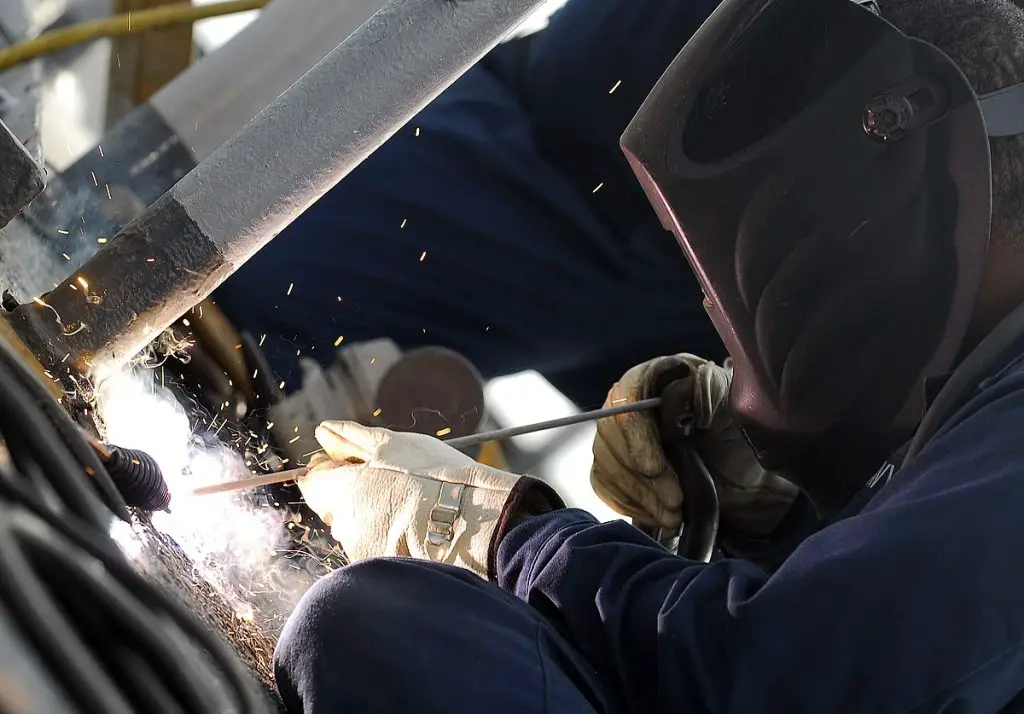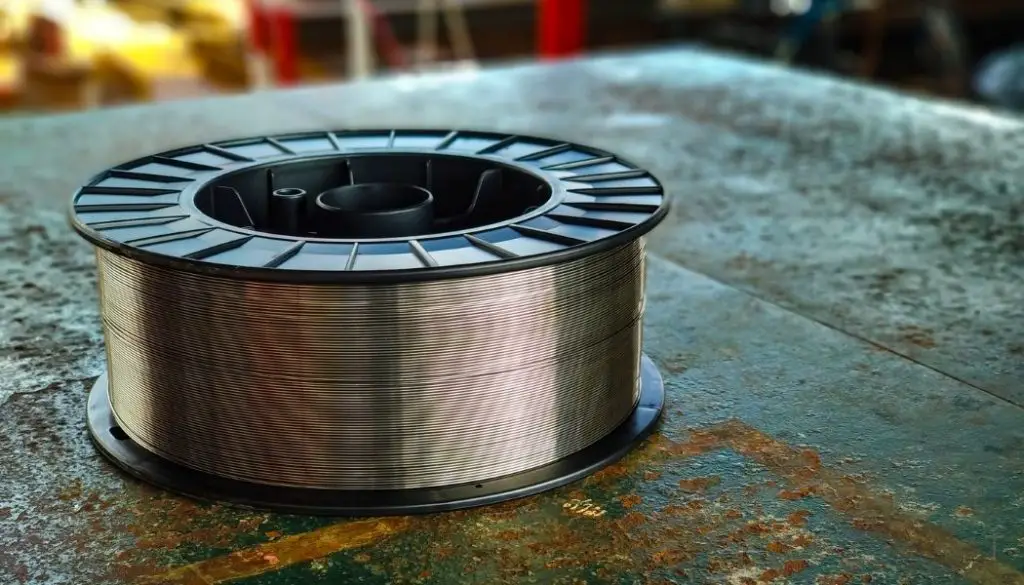Flux core welding wire is the answer to the problems presented by MIG wire. There are two types of flux core wire, self-shielded and gas-shielded.
If you’re used to the Gas Metal Arc Welding (GMAW/MIG) technique, you must be familiar with it using a wire instead of an electrode.
Traditional MIG welding requires an inert gas (the “I” in MIG) to shield the base metal from atmospheric gases. This improves the weld quality and makes the metal pool less porous and brittle.
But what if you’re welding in windy weather that can disperse the compressed gas? Well, the answer is Flux Core welding wire.
Table of Contents
What Is Flux Core Welding Wire?
MIG welding wire is made of solid metal alloy shielded externally by a compressed gas tank. The gas shoots out from the MIG gun and prevents the weld pool from combining with oxygen, nitrogen, or water vapor.
These atmospheric gases oxidise the weld pool, causing inclusions of gas particles that make the weld brittle and unusable. That’s why using a shielding gas or a flux material is crucial to the final result of the weld.
Flux core wire is made of similar alloys to the solid wire. The only difference is that it has a core of flux chemicals that, when heated, vaporize creating a cloud of shielding gas and a slag layer that protects the weld.
You can use flux core wire for the same applications as solid core MIG wire. It provides similar performance and allows for comparable results to the solid core wire.

Different Types of Flux Core Welding Wire Types
Flux core welding wires come in two types:
- Self-shielded
- Gas-shielded
Self-shielded Flux Core Wires (FCAW-S)
Self-shielded welding wires are called that because they have a core of flux material that vaporizes when the arc initiates and the heat increases. This helps the wire create its own cloud of shielding gas to protect the welding site from atmospheric gases.
They’re meant to be used as a standalone alternative to solid core MIG wire with no gas cylinder. This makes sense in windy conditions, where the compressed gas won’t linger for long enough around the welding site to do its job.
That gives self-shielded wires a great advantage, since they require much less equipment to haul around than gas-shielded wires.
Also, there are time savings when you use self-shielded wire. That’s because the continuous wire doesn’t require downtimes for electrode changes like you do when the electrode is spent in stick welding. This ends up being more convenient, especially in larger-scale jobs.
There are a few downsides to self-shielded flux core wires, though. The first is the increased amount of smoke and sputter resulting from using this type of wire. This makes the welding process arduous because of low visibility. It also makes the cleanup more time-consuming.
Self-shielded flux core wires are available in 0.035, 0.045, 0.052, 1/16, 5/64, 3/32, and 7/64 inch diameters, which is the industry standard.
Gas-shielded Flux Core Wires (FCAW-G)
Gas-shielded flux core wires are exactly what they sound like. They’re MIG wires that utilize the effect of pressurized gas cylinders, as well as a flux core, to shield the weld pool.
They have an advantage over solid core welding wires because they are easier to manipulate. However, they truly shine when compared to their self-shielded counterparts.
Self-shielded flux core wires require a higher percentage of flux material inside the core to form their own gas shield. This causes the deposition rate of the wire to be around 65%.
Compare that to gas-shielded flux core wires, which deposit with a 75–85% efficiency, and you can clearly see the winner.
That’s still lower than solid core wire efficiency, which should be around 100%. But with the ease of use and more aesthetic results, it ends up being up to the operator’s preferences.
The major downside here is cost, since gas-shielded flux core wires are more expensive than solid core, and also require the added cost of a gas cylinder. They’re less expensive than self-shielded flux core wires, but those don’t have any additional costs to worry about.
That said, gas-shielded flux core wire is a pretty popular choice in workshop settings, since it doesn’t require any physical barriers like it would in the windy outdoors.
Just like the self-shielded variety, gas-shielded wires come in 0.035, 0.045, 0.052, 1/16, 5/64, 3/32, and 7/64 inch diameters.

How to Read Welding Wire Numbers
The American Welding Society (AWS) has a code for all types of electrodes used for welding. Whether you’re using a solid core welding wire (code A5.18), or a flux core wire (code A5. 20), you can find out how to read the wire number to know more about its specifications below.
Solid Core Welding Wire (AWS A5. 18)
Let’s take this example of a solid core wire: ER70S-3 H4
- ER – The E stands for electrode and the R stands for rod. That’s because solid welding wires can be used as welding rods with a TIG gun when cut to standard lengths.
- 70 – These two or three digits denote the tensile strength of the wire metal measured in KSI (Kilopounds per square inch).
- S – Stands for Solid Core, optional in the naming
- 3 – This number denotes whether the alloy was treated with metal deoxidizers or any other chemical additives that affect the polarity of the wire. Number 3 is relatively additive-free.
- H4 – This stands for diffusible hydrogen requirements. H4 wires can take less than 4 ml/100gm.
Common Solid Core Wire Numbers:
- ER70S-6: mild steel wire with deoxidizers
- ER5056: aluminum wire with high ductility
- ER5356: aluminum wire with high tensile strength
- ER308–L: stainless steel wire, the L stands for low carbon
Flux Core Welding Wire (AWS A5. 20)
Let’s examine this code of a gas-shielded flux core welding wire: E70T-1C H8
- E – Stands for electrode, no R this time around because flux core wires aren’t used for TIG welding.
- 7 – Tensile strength in 10 KSI or PSI x 10,000
- 0 – This number denotes the positions of the weld. A zero means for flat and horizontal welding only, a number one is good for all positions
- T – Stands for Tubular wire
- 1 – Denotes performance capabilities of the wire in terms of additives. The numbers go from 1–14, with 1 being the most acidic slag system and 14 the most basic slag system.
- C – Stands for the use of CO2 shielding gas only. An M in its place would stand for a mixture of argon and CO2
- H8 – Diffusible hydrogen requirements of less than 8 ml/100g.
Common Flux Core Wire Numbers:
- E71T-H8: self-shielded wire. This is the AWS code for Lincoln Electric’s NR-232 wire.
- E71T-9C/M
- E70T-3
- E71T-12C/M
How to Pick the Correct Welding Wire Type
You should have an idea about the specifications of the welding wire you choose depending on your project. Physical factors of the wire affect the weld quality, strength, and longevity, almost as much as the welding technique.
Here are a few things to consider when choosing the correct wire type for your project:
Appearance
This one mostly depends on the thickness of the base metal you’re using. Thinner metal sheets usually require more precise welds with less slag to clean off before painting. That’s why solid core welding wire is better for these applications than flux core.
Working Location
Using solid core wires for MIG welding requires relatively sheltered working conditions, like the inside of a workshop. That’s because wind can cause rapid dispersal of the inert gas shield, causing the weld to become porous and unusable.
Self-shielded flux core wire is the direct answer to this problem, since it doesn’t need a compressed gas cylinder to do its job.
Wire Gauge
You should use thicker-gauge wires with thick metal sheets. This one should be a no-brainer, but some welders believe using a one size fits all approach to different projects is okay.
While it can work for some projects, you should be attuned to the requirements and look for the best final results. That’s true even if you should learn how to work with some new material or technique for each new project.
Final Thoughts
Learning about flux core welding wire types and applications can help you find what you need for your next welding project. This is especially important if you do a lot of outdoor welding work that requires being in windy conditions, where a regular MIG setup wouldn’t work.
Flux core wire is either self-shielded or gas-shielded. The former type doesn’t need any compressed gas to protect the weld pool as it produces its own. This makes it perfect for locations where carrying a gas cylinder would be difficult.
As for gas-shielded wire, it requires the help of either compressed CO2 or a mix of the inert gas argon and CO2. That means it’s closer to solid core wire than self-shielded. That said, this type is easier to manipulate than solid core and is known to produce better results.
